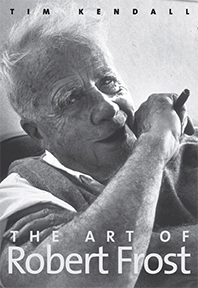By John P. McWilliams
The Art of Robert Frost is not a book for readers who seek probably apocryphal anecdotes about the craggy sage of yesterday’s northern New England. Nor is it a book for those who seek the memorable aphorisms, ‘wise saws and modern instances,’ of a poet beloved from childhood. Nor is it a book for trendies more interested in the latest literary theory than in lasting literature. It is, rather, a book intensely true to the implications of its title. Kendall gives us sustained reflection, poem by poem, on Frost’s poetic craft. He explores the ways in which conversational diction, dramatic dialogue, rhythm and rhyme, “breaking the sounds of sense across the regular beat of the metre,” enabled Frost to achieve a poetic idiom accessible and rewarding to readers at every level of literary experience. In similar fashion, Kendall’s book will guide a newcomer to understand the essence of Frost’s art, while providing the Frost scholar new and challenging readings of poems, many of them familiar, but many comparatively neglected.
Half of Kendall’s pages consist of Frost’s poems, reproduced in toto and in near accord with their ordering in the Complete Poems. The other half consists of careful, precise three to five page explications that immediately follow each poem Kendall has selected. The approach is thus an amalgam of the close textual approaches of “New Criticism” and of “Reader Response Criticism.” The reader experiences the entirety of a Frost poem, then is given a reading of it that combines close attention to poetic detail with pertinent biographical information, comparisons to other poems, and citation of insights from other Frost scholars. This approach is far more risky than it seems. Kendall brings a Frost poem in its entirety directly beneath the close scrutiny and sought appreciation of his reader. There can be no excision of the one or two lines that are useful to prove the critic’s thesis while ignoring the rest of the poem. Every reader will question the conclusions of some of Kendall’s interpretations, but any reader who would charge Kendall of a clear misreading had best be careful. Kendall’s responses to individual words, to poetic forms and to the whole of a poem are nuanced, sensitive and deeply informed.
Kendall is particularly insightful in maintaining a continuing inter-textual dialogue between Frost’s poems and their Romantic predecessors, in particular the poems of Wordsworth. With benefit to both poets, Kendall reads “An Old Man’s Winter Night” as a rejoinder to Coleridge’s “Frost at Midnight,” “The Black Cottage” as a response to Wordsworth’s “The Ruined Cottage,” and “The Most of It” as an analogue to Wordsworth’s “There Was a Boy.” (And why not, one wonders, compare Frost’s “After Apple-Picking” to Keats’s “To Autumn”—two of the perfect poems in the language). Frost’s emphasis on the fear, animus, marital difficulties, and sheer labor of rural life emerge as decidedly separate from Wordsworth’s emphasis on resolution, independence, and endurance. An equally informative kind of inter-textual dialogue could have been set up between Frost and his New England predecessors, Emerson and Thoreau, though Kendall chose not to do so.
Every reader will demur from some of Kendall’s selections of poems to be analyzed. I miss “Tree at My Window,” “Provide, Provide,” “A Drumlin Woodchuck,” and especially “West-running Brook.” I could have done without “Christmas Trees,” “Hyla Brook,” “A Star in a Stone Boat,” and “The Two Witches.” No matter. Every reader will gain greatly from less familiar poems Kendall will open up or renew—in my case “The Onset,” “A Hillside Thaw,” “The Vanishing Red,” and “The Ax-Helve.” Kendall shows us how carefully, and to what end, Frost balanced the first and last poems in his first three volumes of poetry. Kendall gives us no less than 120 pages on the entirety of Frost’s North of Boston, but every page is worth it, because of the sustained quality of both the poems and the explications. Kendall’s reader is never allowed to forget that Frost was forever playing a skillful game of “ulteriority,” luring the reader into assuming an ulterior meaning beyond the seemingly simple surface, while refusing directly to divulge it. In poem after poem, Kendall shows us the fine fruits of Frost’s reminder: “But all the fun’s in how you say a thing.”
John P. McWilliams (ΦBK, Princeton University, 1962) is a professor of humanities at Middlebury College and a resident member of the Beta of Vermont chapter of Phi Beta Kappa.




